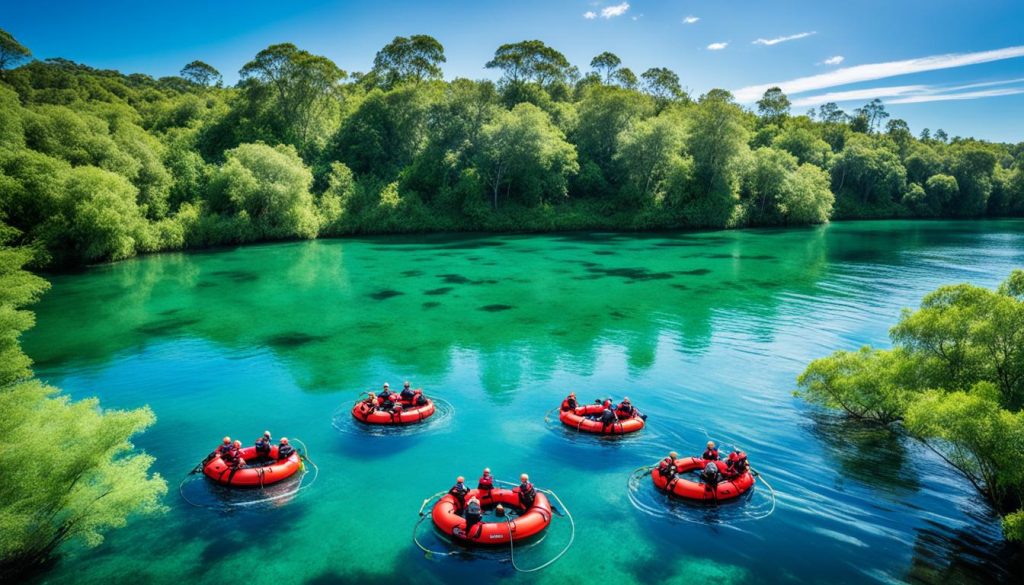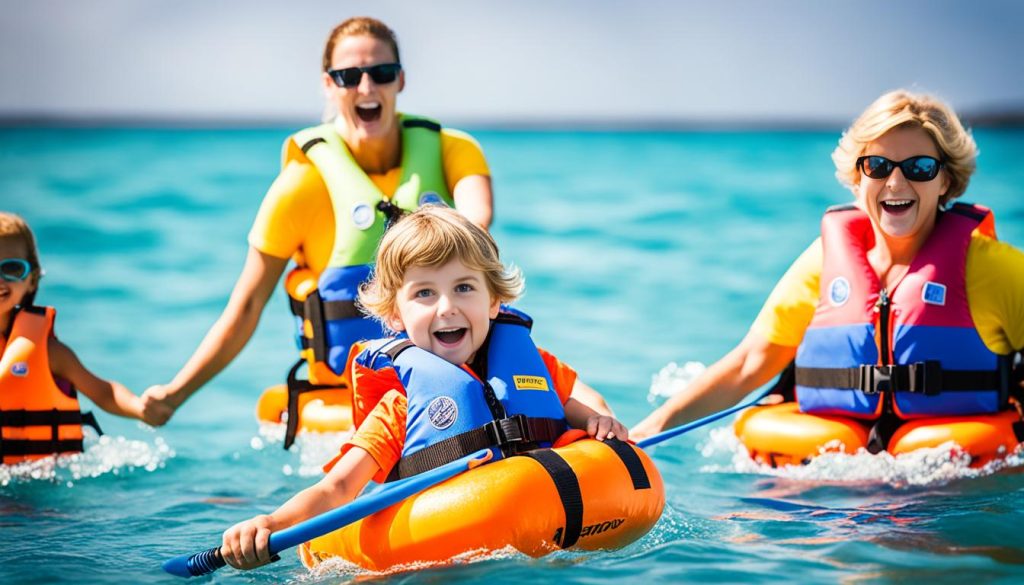Did you know that drowning is the second leading cause of unintentional injury-related death worldwide?
Water accidents can occur to anyone, no matter how good you swim. That’s why it’s vital to learn how to be safe in the water.
Aquatic Survival Skills Training Programs are more than just swimming lessons. They cover many skills to keep you safe in and around water.
These training programs teach water survival and rescue skills. They also show how to stay safe in open water to prevent drowning and encourage safety.
Key Takeaways:
- Water Survival Training programs enhance water safety and help prevent drowning incidents.
- These programs teach essential skills such as water rescue skills and open water survival techniques.
- Water-related accidents are a global concern, making water safety education crucial for everyone.
- By participating in Aquatic Survival Skills Training Programs, individuals can gain the confidence and knowledge to navigate various aquatic environments.
- Enhancing water safety is a collective responsibility that requires proactive measures, such as proper training and drowning prevention strategies.
Water Survival Training for Maritime and Aviation Professionals.
Water survival training is key for those in the maritime and aviation fields. It teaches participants how to survive and respond to water emergencies. This knowledge is crucial for their safety.
Workers at sea, like sailors and fishermen, deal with tough situations. So do flyers, who must handle emergencies over water and land. Water survival training prepares them for any crisis.
Knowing what to do post-incident is also critical. This kind of training equips them with important skills. They learn how to handle issues like leaving a sinking plane, avoiding hypothermia, and finding help.
In the training, they practice real-life scenarios. This includes using signals and pyrotechnics for rescues. Such hands-on training is vital for their safety.
This training makes maritime and aviation workers ready for risks. It boosts their confidence and skill level. Safety is a top priority in their jobs, and this training is a big part of it.
Hazard Awareness and Hypothermia Mitigation
“Water survival training gives a deep look at the dangers of our jobs,” says Captain Amelia Wright. She’s a seasoned pro at sea. “We learn how to spot risks and lower them.”
It also teaches how to avoid hypothermia, a deadly risk in cold water. Knowing this saves lives.
Investing in water survival training is crucial for safety. It equips professionals to act in emergencies. This boosts safety for everyone involved.
Location and Certification for Water Survival Training.
The place for water survival training is key. At Survival Systems USA, we’re located in the Long Island Sound, Groton, CT. This beautiful coast is perfect for learning and practicing water survival skills. The area is ideal for training like real emergencies where the water scenes are life-like.
The training here lets people see all New England’s changing seasons. They work in the heat of summer and the cold of winter. This variety helps them prepare for any weather, making them ready for real water survival challenges.
Our indoor areas are kept at a comfortable temperature for everyone’s safety. If the weather’s bad or for special exercises, we train inside. This makes the learning condition just like real events, boosting confidence for tough situations.
After finishing the course, each participant gets a certificate from Survival Systems USA. This shows their hard work and everything they learned. It’s great for their job applications, especially in places that require water survival skills.
Our water survival training is special. It combines great places, all four seasons, and indoor training. With our certification, people can start careers in many fields. These include maritime, aviation, and emergency response, needing vital water safety skills.
Aquatic Survival Skills Training for Children.
Teaching kids how to stay safe in the water is super important. The Aquatic Survival Skills Trust (ASST) creates special programs just for them. These programs get children ready to be safe in pools, oceans, rivers, and on boats.
The ASST makes sure kids can have fun in the water the right way. They mix classroom lessons with real water practice. Kids learn to swim better, stay afloat, and spot dangers. They study pool, beach, and river safety closely.
Understanding about pool safety is key in the ASST program. They teach kids to know the dangers and how to dive safely. Kids also learn the right way to get in and out of the water. This helps them lower the chance of accidents in pools.
“Our goal is to provide children with the confidence and skills they need to enjoy water activities safely,” says Sarah Johnson, the ASST program director. “We believe that by teaching children life-saving skills and water safety education, we can significantly reduce the risk of drowning incidents.”
The ASST also focuses on beach safety. Kids find out about strong ocean currents and how waves work. Being close to a lifeguard is stressed as important. They practice good swimming habits at the beach. This prepares them to handle danger well.
River safety is another important part of the ASST program. They learn about strong river currents and what to do around boats. Kids also learn the value of wearing a life jacket and river safety rules. This helps them make smart choices and stay safe near rivers.
The ASST program makes learning fun with games and real-life examples. Every child gets focused attention from instructors. This way, they really understand and remember what they’re taught.
In the end, the Aquatic Survival Skills Trust makes sure kids know how to be safe near water. They learn about pool, beach, and river safety. This prepares them for good times in the water, while being careful. The ASST program is critical in avoiding drownings and improving water safety everywhere.
Water Survival Training for Emergency Responders.
In emergencies with water, what responders know and can do is critical. Water survival training is made to give them the emergency skills they need. This includes water survival, emergency response, helicopter safety awareness, underwater escape procedures, and search and rescue operations.
Responders often face tough tasks near or in water. This could be rescuing in floods or at sea. The right training keeps them safe and helps those they help.
Water survival training talks about many key things. Helicopter safety awareness is one big area. It teaches how to get onto helicopters in water right. Knowing about risks helps in safer rescues.
Learning about underwater escape procedures is crucial too. This training shows how to get out of sinking vehicles calmly. Knowing exits and using tools could save lives.
Training also highlights search and rescue operations. Responders learn great search skills and how to work well with others in water rescues. They also pick up tips on equipment use and rescue tactics.
These programs give responders the emergency skills they need for water issues. They learn to check risks, choose wisely, and lower dangers. This keeps everyone safer.
Water survival training is key for emergency teams. It prepares them well for water emergencies. With this training, responders can better save lives and help in crisis situations.
Customized Water Survival Training for Specific Industries.
Different companies and organizations can gain from special water survival training. This training fits their needs for safety. Whether you’re in offshore wind energy, law enforcement, sailing, or research out at sea, these trainings make sure you’re ready for water emergencies.
Offshore wind energy workers get unique training. They learn about safety out at sea. This includes how to stay safe in a helicopter, how to leave fast, and surviving tough weather.
Law enforcement also gets special water training. This helps them face dangers in water. They learn how to get out of underwater spots, help people, and act quickly in emergencies.
Sailors and yachters learn how to stay safe on water with special training. They practice using safety gear, learn what to do in an emergency, and how to survive. This way, they can handle surprises and keep themselves and others safe.
Scientists on board research ships also learn how to be safe at sea. Their training includes what to do in ship emergencies, how to do drills, and how to save others in water. This prepares them for working in tough marine places.
Special water survival training is important for many jobs. It teaches skills that fit each job’s dangers. This makes sure workers are ready to face water problems with what they’re taught.
| Industry | Training Focus |
|---|---|
| Offshore Wind Energy | Helicopter safety awareness, evacuation procedures, survival techniques |
| Law Enforcement | Underwater escape procedures, search and rescue operations, emergency response protocols |
| Yachting/Sailing | Safety equipment usage, emergency procedures, survival techniques |
| Scientific Research Vessel Operations | Onboard safety protocols, emergency drills, water rescue techniques |
Training is made to fit each kind of job. This way, everyone learns what they need to stay safe in the water.
Conclusion.
Water survival training is key to making the water safer and stopping drowning. It teaches people important skills for saving others and staying safe in emergencies. With more education and training, everyone can enjoy water activities without as much risk.
Many studies prove that teaching water safety helps, no matter where you live or how much money you make. Big groups like the World Health Organization and the International Life Saving Federation share advice to make water safer and to cut drowning numbers.
There are also special training courses for folks who work near or on the water, like in maritime jobs, flying, or responding to emergencies. They learn things like how to deal with cold water, find and save people, and how to act fast in a crisis. This kind of education saves lives.
By putting more money and effort into this kind of training and teaching, we can stop many drownings. Learning how to survive in water doesn’t just keep you safe; it makes communities all over the globe better places. Everyone benefits from knowing how to stay safe in and around water.


